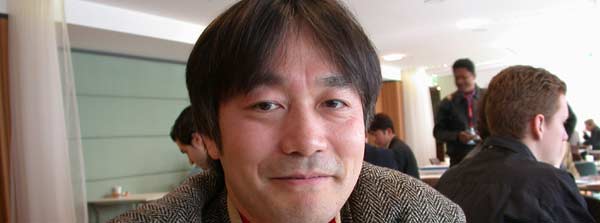| deutsch? | |
 |
|
|
|
An interview with Roland's Masato Kamikoriyama, who leads the development team for this new synthesizer. |
 |
|
| I met Masato Kamikoriyma for a brief interview at the Frankfurt Music Fair Musikmesse on March 5, 2003. Masato leads the team which developed a new synthesizer based on granular synthesis, the V-Synth. Roland dedicated a website with several videos and sound samples to this machine which you might want to visit. | |
|
|
.
 |
|
.The Interview consists of two parts. In the first part we talk about what comes after the V-Synth, about time control and problems with the playability of human voices on a keyboard. We touch on the subjects of morphing and convolution and the idea of a future instrument for non-keyboard players and DJs. |
|
| The second part is about granular synthesis of sound, the development team and Masatos own career. We also talk about how hard it is to find skilled programmers and engineers in Japan. | |
|
The audio content on these pages is in Real Audio format, so you need Realplayer to hear it. Don't be irritated by brief sine tone interruptions. They are there to indicate that this is copyrighted material which must not be used for other than private purposes. |
|
 |
Alle Töne auf dieser Seite sind im Real Audio Format kodiert, also brauchen Sie den Realplayer, um sie zu hören. Die kurzen Sinustöne sollen darauf hinweisen, dass das Material geschützt ist und nur zu privaten Zwecken genutzt werden darf. |
| mehr Radiodinge | |
|
Ich habe das Interview in englischer Sprache während der Musikmesse 2003 in Frankfurt geführt. Der V-Synth ist ein bahnbrechender neuer Synthesizer, der auf der Granularsynthese von Klängen beruht und in den nächsten Jahren neue Soundwelten erschließen helfen wird. Masato Kamikoriyama ist Entwicklungschef der V-Synth-Abteilung bei Roland in Japan. Roland widmet dem Instrument eine eigene Webseite.
Im ersten Interviewteil sprechen wir darüber, wohin das, was das innere und äußere Konzept dieses Synthesizers ausmacht, in Zukunft führen wird, z.B. zu einer leichten Spielbarkeit menschlicher Stimmen. Im zweiten Interviewteil geht es um Granularsynthese, um Masatos Karriere und die Schwierigkeiten, talentierte Programmierer und Ingenieure für solche Aufgaben zu finden. |
| Teil 1 |